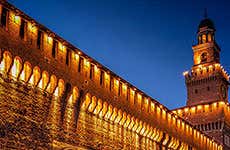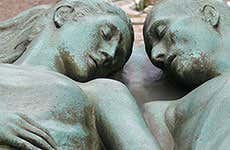
The Last Supper by Leonardo da Vinci
Leonardo da Vinci's "The Last Supper" (Cenacolo Vinciano), created between 1495 and 1497, is one of the most famous paintings in the world.
The Last Supper by Leonardo da Vinci (Cenacolo Viniciano) is one of the most renowned paintings in the world. The original mural was painted between 1495 and 1497. Visitors can currently see the authentic picture which da Vinci painted in the dining room of the Convent of Santa Maria delle Grazie.
The Last Supper is an enormous painting that measures 640 cm x 880 cm. Leonardo da Vinci used tempera and oil on a base of plaster, instead of using the most frequent technique of the time: fresco.
The creation of The Last Supper
At the end of the fifteenth century, the Dominicans were lucky enough to have two of the greatest artist of the time decorate their temple thanks to Ludovico Sforza, Duke of Milan. Sforza was Leonardo’s patron and he wanted to convert the convent into a mausoleum for his family, thus commissioning The Last Supper. Nevertheless, Ludovico didn’t manage to make his wish come true. He was handed over to the French by the Swiss and died imprisoned.
Leonardo da Vinci investigated the theme relentlessly and made numerous sketches before painting the scene. Those that witnessed the artist working on his painting say that he behaved extremely strangely during the whole process. Sometimes, he would start painting at dawn and wouldn’t even stop for lunch and at other times he would wander the streets aimlessly looking for people to inspire him, or he would just stare at his work in a daze.
Interestingly, da Vinci did not get paid for this work of art, even after dedicating three years of his life to it, nor did he seem to want to be paid.
A survivor
The painting suffered with the passage of time since it was painted on dry plaster. The work started to flake off as soon as the painting was finished. During the eighteenth and nineteenth centuries, there were several failed attempts at restoration.
During the Napoleonic Wars, the troops would use the wall for target practice and in 1943 the building’s roof was bombed leaving the painting out in the open for several years.
After years of restoration, The Last Supper has regained some of its original beauty and can be observed by those who book their visit in advance.
Interesting facts about the painting
Even though the subject has been represented in thousands of occasions by various artists, Leonardo captured one of the most crucial parts of the dinner when Jesus announces that one of his apostles will betray him. The painting is so powerful and realistic that it expresses the astonishment, horror and surprise of his 12 disciples.
Although da Vinci had named all the apostles in his sketches, some of the figures are not very clear. For example, the figure next to Jesus looks very feminine so many experts believe it to be Mary Magdalene, instead of the apostle John.
This idea is also represented in Dan Brown’s book, The Da Vinci Code, where he identifies the person on Jesus’s right to be Mary Magdalene and gives the painting an esoteric meaning. The film The Da Vinci Code was released in 2006 starring Tom Hanks and Audrey Tautou based on Dan Brown’s novel.
Book the tickets in advance
If you would like to see The Last Supper you will need to book in advance. The visits are organized in small groups, which rotate every 15 minutes, making it a very enjoyable visit. Note that you are not allowed to take photos.
You can book your tickets in advance by clicking here:
Santa Maria delle Grazie
The church and convent Santa Maria delle Grazie was established in 1463. It was commissioned by the Duke of Milan Francesco I Sforza as part of the Dominican Order. The original architect was Guiniforte. Years later, it was completed by Bramante in 1492, who built a beautiful dome, a cloister, refectory and semi-circular apses.
If we compare Santa Maria’s architecture with the rest of the churches in Milan, it certainly does not stand out. It is thanks to the painting of The Last Supper that it has become renowned worldwide.
A small part of the Pinacoteca Ambrosiana’s collection (Ambrosian Art Gallery) is contained in the temple’s sacristy. Tourists will be able to observe some of the pages of the Codex Atlanticus, a collection of writings and drawings by Leonardo da Vinci. However, in our opinion, it has little else that is worth seeing. The most interesting exhibition is in the Biblioteca Ambrosiana.


Schedule
Tuesday to Friday: 8:15 am until 7 pm
Monday: closed
Price
Adults: € 12 (US$ 12.90)
Young people (aged 18 to 25): € 7 (US$ 7.50)
EU citizens (less than 18 and over 65) € 2 (US$ 2.20)
Last Supper Tour € 59 (US$ 63.50)
Transport
Tram: Corso Magenta - Santa Maria delle Grazie, line 18.
Metro: Conciliazione, Cadorna, line M1; Cadorna, line M2.
Nearby places
Museo della Scienza e della Tecnologia (365 m) Basilica di Sant'Ambrogio (587 m) Milan Archaeological Museum (615 m) San Maurizio al Monastero Maggiore (647 m) Triennale (725 m)

